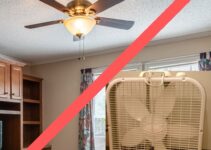Most of us forget to change the winter ceiling fan setting when winter arrives. As a result, we waste a lot of energy and money due to our inefficient winter ceiling fan setting. Don’t let your wallet suffer; follow this helpful guide to the perfect winter ceiling fan setting and save money this winter!
Here is a quick check-list to help you safely winterize your ceiling fan:
#1 Don’t Forget to Reverse the Direction

By reversing the direction of your fan, you can subtly circulate the warm air in your home and create a winter sanctuary that everyone will love. It’s as simple as flipping a switch – no winter jackets are required!
Warm air tends to rise, and cold air settles down. Reversing the direction of your fan in winter pushes the warm air back down, keeping your home comfortable and heated more efficiently throughout winter.
If you’re unsure which direction is your ceiling fan’s current setting, simply stand underneath the fan and feel the air on your face. If the air is blowing down, your ceiling fan is set for summer. For winter, your winter ceiling fan setting should be set to reverse to blow the air up.
Here is a detailed guide on Ceiling fan direction clockwise or anti-clockwise in winter.
#2 Time to Lower the Ceiling Fan Speed (RPM)

In winter, you don’t need a high-speed ceiling fan to cool you down. You just require your ceiling fan to slowly move the warm air in your home and keep winter chills at bay. A slower winter ceiling fan setting requires less power and helps to maintain the warmth in your home.
Lowering your fan speed to the winter ceiling fan setting can significantly reduce energy consumption and make your winter nights cozy and comfortable. Plus, you’ll be able to keep your winter utility bills in check.
It’s a win-win!
#3 Adjust the Blade Angle (If Your Ceiling Fan Has This Setting)

When winter arrives, it’s time to adjust the blade angle of your ceiling fan. By tilting the fan blades higher than their usual angle, winter ceiling fans can produce an updraft, helping to better re-circulate the warm air in your home for more efficient winter heating at lower speeds.
To do this, you’ll need to remove your fan’s blades and adjust the angle on each blade. Once done, you can be sure that your winter ceiling fans are running as efficiently as possible for winter. If you’re uncomfortable doing this yourself, you can always call a professional.
#4 Listen For Abnormal Noises and Vibrations

Once the summer ends and winter arrives, it’s a good practice to check for any noises or vibrations that weren’t present before winter. This could indicate a need for winter maintenance and repairs, which can prevent winter problems from developing into larger winter issues.
You can choose to DIY if you’ve got the winter blues and are looking for a winter project, or call in an expert to customize your winter ceiling fan setting. Keep your winter ceiling fan setting in check to enjoy a winter season that is both comfortable and cost-effective.
#5 Not Planning to Use Your Fan in Winter? Cover The Blades
If you are not planning to use your ceiling fans in winter, remember to cover your blades to minimize dust accumulation. You can find lots of ceiling fan covers easily on Amazon and order a few that match the interior of your home.
Check out these fantastic winter ceiling fan settings and start winterizing your home today to enjoy winter in comfort!
Is It Safe to Switch On Ceiling Fans in Winter?
The short answer is yes! It is perfectly safe to turn on ceiling fans in winter, but you must take some basic precautions. Ceiling fans work to redistribute heat in winter and can help save energy. It’s important to remember that ceiling fans should be switched on in winter and set to reverse so as to push the warm air down. This winter ceiling fan setting can help to create a more comfortable atmosphere in the winter months.
Final Word of Advice!
Don’t let winter come without changing your winter ceiling fan setting! Take the time to properly winterize your fan and enjoy winter nights in the comfort of your own home. Be sure to follow the checklist above to ensure that you are making the most of winter and saving money in the process.
Get winterizing your home today! Happy wintering!
FAQs
Which direction should my ceiling fan go in the winter?
Your winter ceiling fan setting should be set to reverse so that it will push the warm air down and spread it around the room. This will help keep your home warm and toasty on those chilly winter days. Additionally, you can use a ceiling fan in the winter months to save energy and money. By running the fan on a low setting, you can help reduce winter heating costs. It’s an easy way to create efficient winter warmth!
Winter ceiling fan direction switch up or down?
Your winter ceiling fan setting should be switched to the down position. This will allow the fan to push the warm air downwards and spread it around your living space. This way, you can benefit from the winter warmth while not having to crank up your thermostat.
Is the correct Winter ceiling fan direction switch selection left or right?
Your winter ceiling fan setting should be switched to the left (counter-clockwise) position. This will allow the fan to push the warm air downwards and spread it around your living space. By setting the fan to rotate in a counter-clockwise direction, you can help create winter warmth and keep your home cozy.
Which way should a fan spin in winter?
Your winter ceiling fan setting should be set to rotate in a counter-clockwise direction. This will help circulate the warm air downwards and spread it around your living space. By rotating the fan in a counter-clockwise direction, you can help create winter warmth and keep your home comfortable.
Is it safe to switch on the ceiling fan in winter?
Yes, it is safe to switch on your winter ceiling fan setting. By running the fan on a low setting, you can help reduce winter heating costs and save energy. Additionally, the fan can help circulate the warm air downwards and spread it around your living space, providing winter warmth with minimal effort. Just make sure to switch the direction of rotation to counterclockwise, and you’re all set!





